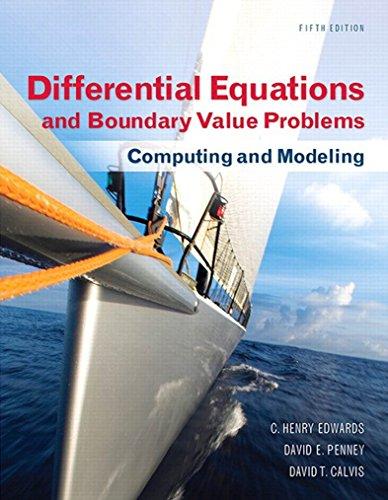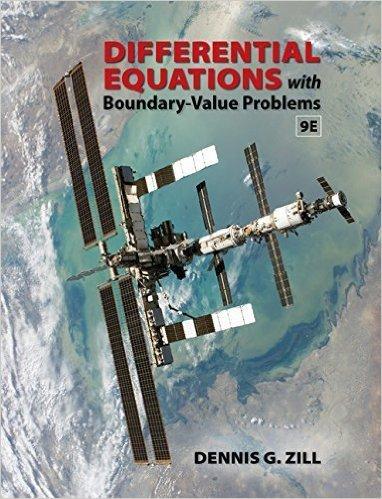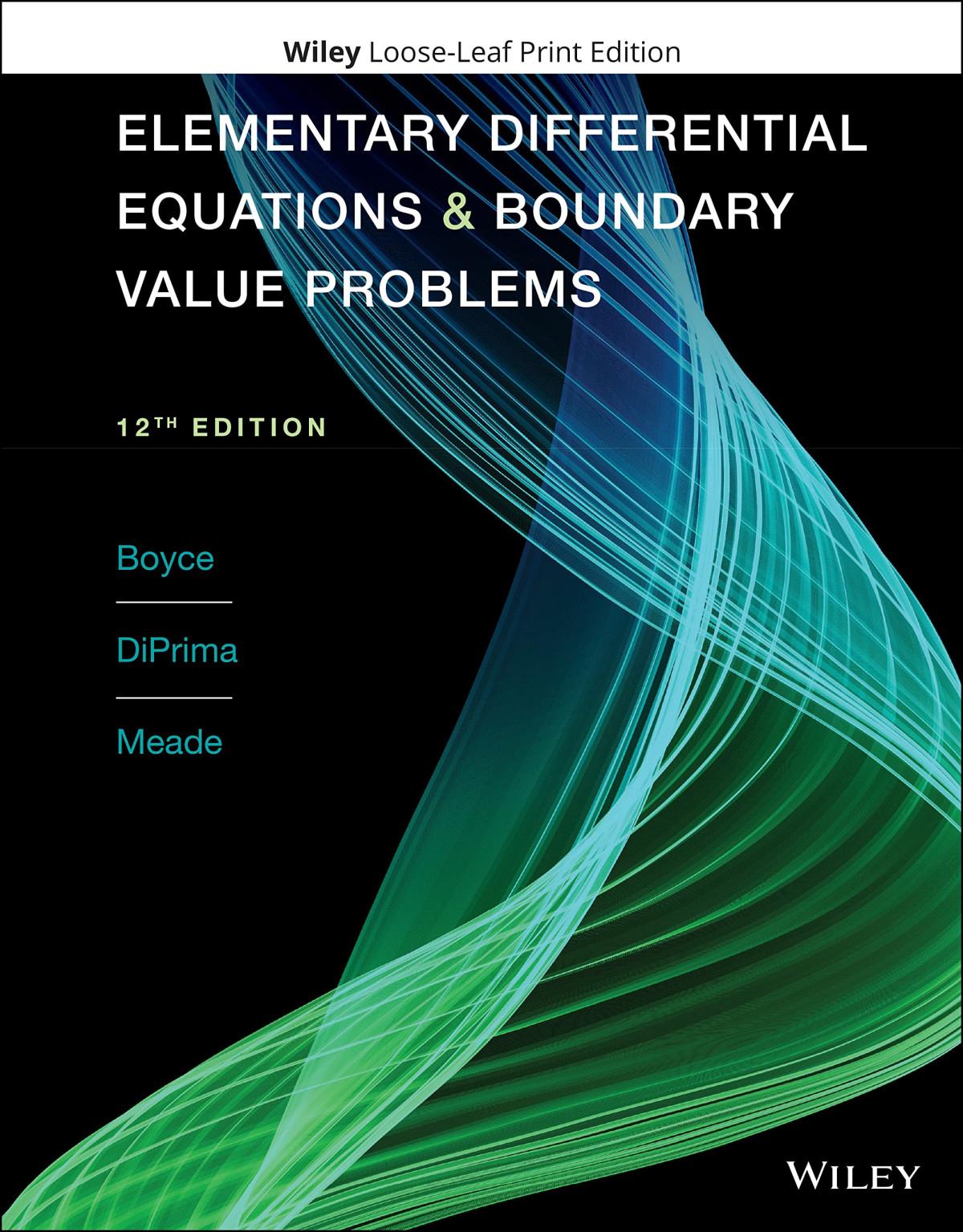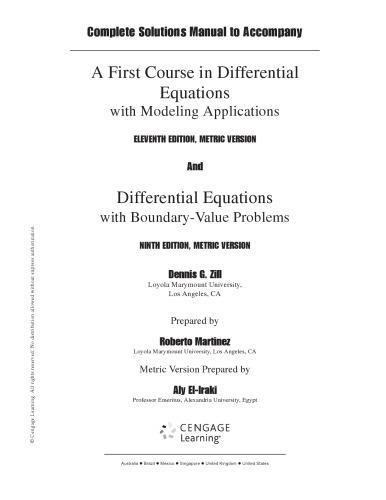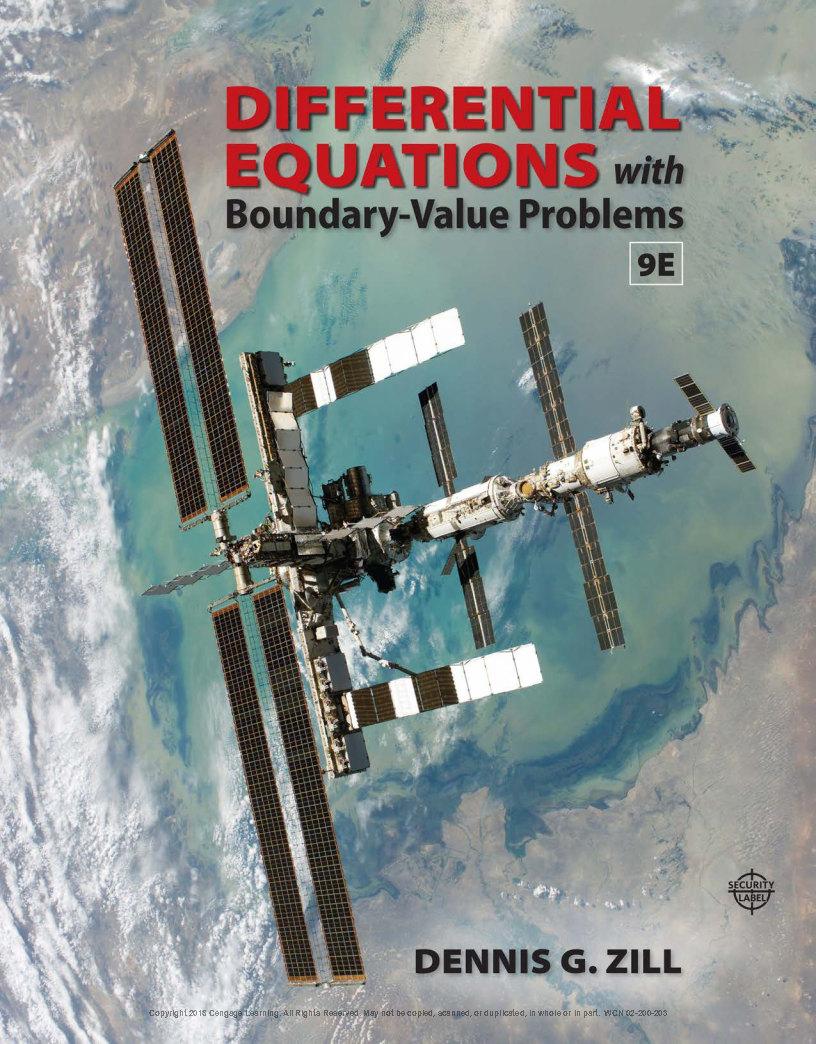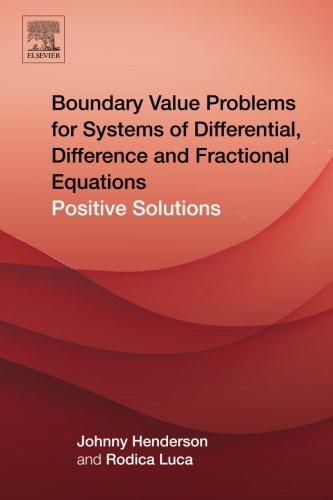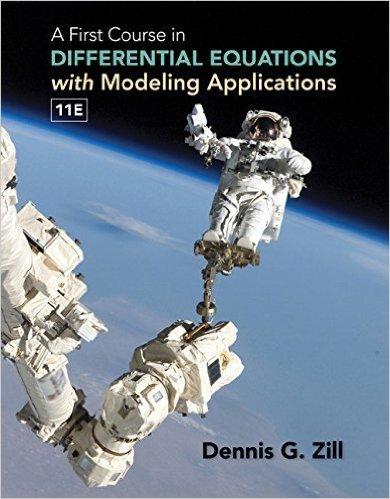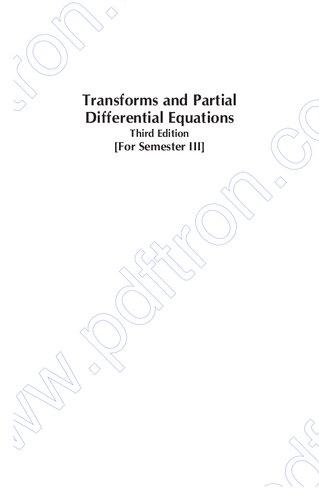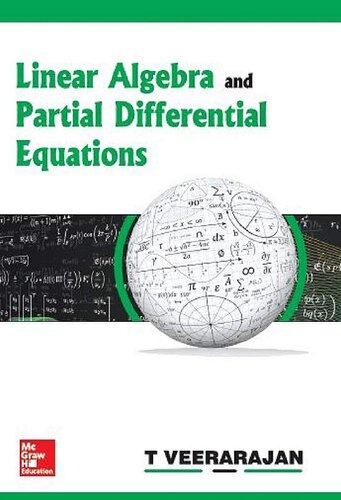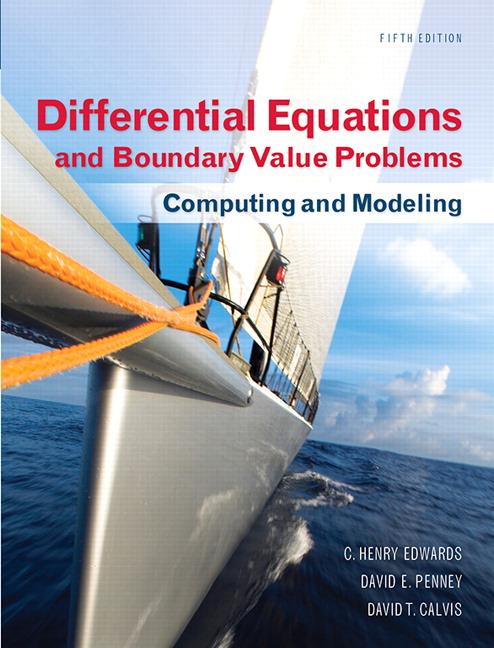PREFACE PREFACE
Thisisatextbookforthestandardintroductorydifferentialequationscourse takenbyscienceandengineeringstudents.Itsupdatedcontentreflectsthe wideavailabilityoftechnicalcomputingenvironmentslike Maple, Mathematica, andMATLABthatnowareusedextensivelybypracticingengineersandscientists. Thetraditionalmanualandsymbolicmethodsareaugmentedwithcoveragealso ofqualitativeandcomputer-basedmethodsthatemploynumericalcomputationand graphicalvisualizationtodevelopgreaterconceptualunderstanding.Abonusof thismorecomprehensiveapproachisaccessibilitytoawiderrangeofmorerealistic applicationsofdifferentialequations.
PrincipalFeaturesofThisRevision
This5theditionisacomprehensiveandwide-rangingrevision.
Inadditiontofine-tuningtheexposition(bothtextandgraphics)innumerous sectionsthroughoutthebook,newapplicationshavebeeninserted(includingbiological),andwehaveexploitedthroughoutthenewinteractivecomputertechnology thatisnowavailabletostudentsondevicesrangingfromdesktopandlaptopcomputerstosmartphonesandgraphingcalculators.Italsoutilizescomputeralgebra systemssuchas Mathematica,Maple,andMATLABaswellasonlinewebsites suchasWolframjAlpha.
However,withasingleexceptionofanewsectioninsertedinChapter5(noted below),theclasstestedtableofcontentsofthebookremainsunchanged.Therefore, instructors’notesandsyllabiwillnotrequirerevisiontocontinueteachingwiththis newedition.
Aconspicuousfeatureofthiseditionistheinsertionofabout80newcomputergeneratedfigures,manyofthemillustratinghowinteractivecomputerapplications withsliderbarsortouchpadcontrolscanbeusedtochangeinitialvaluesorparametersinadifferentialequation,allowingtheusertoimmediatelyseeinrealtimethe resultingchangesinthestructureofitssolutions.
Someillustrationsofthevarioustypesofrevisionandupdatingexhibitedin thisedition:
NewInteractiveTechnologyandGraphics Newfiguresinsertedthroughoutillustratethefacilityofferedbymoderncomputingtechnologyplatforms fortheusertointeractivelyvaryinitialconditionsandotherparametersin realtime.Thus,usingamouseortouchpad,theinitialpointforaninitial valueproblemcanbedraggedtoanewlocation,andthecorrespondingsolutioncurveisautomaticallyredrawnanddraggedalongwithitsinitialpoint. Forinstance,seetheSections1.3(page28)applicationmoduleand3.1(page 148).Usingsliderbarsinaninteractivegraphic,thecoefficientsorotherparametersinalinearsystemcanbevaried,andthecorrespondingchangesinits directionfieldandphaseplaneportraitareautomaticallyshown;forinstance,
seetheapplicationmoduleforSection5.3(page319).Thenumberofterms usedfromaninfiniteseriessolutionofadifferentialequationcanbevaried, andtheresultinggraphicalchangeinthecorrespondingapproximatesolution isshownimmediately;seetheSection8.2applicationmodule(page516).
NewExposition Inanumberofsections,newtextandgraphicshavebeen insertedtoenhancestudentunderstandingofthesubjectmatter.Forinstance, seethetreatmentsofseparableequationsinSection1.4(page30),linearequationsinSection1.5(page45),isolatedcriticalpointsinSections6.1(page 372)and6.2(page383),andthenewexampleinSection9.6(page618) showingavibratingstringwithamomentary“flatspot.”ExamplesandaccompanyinggraphicshavebeenupdatedinSections2.4–2.6,4.2,and4.3to illustratenewgraphingcalculators.
NewContent ThesingleentirelynewsectionforthiseditionisSection 5.3,whichisdevotedtotheconstructionofa“gallery”ofphaseplaneportraitsillustratingallthepossiblegeometricbehaviorsofsolutionsofthe2dimensionallinearsystem x0 D Ax.Inmotivationandpreparationforthe detailedstudyofeigenvalue-eigenvectormethodsinsubsequentsectionsof Chapter5(whichthenfollowinthesameorderasinthepreviousedition),Section5.3showshowtheparticulararrangementsofeigenvaluesand eigenvectorsofthecoefficientmatrix A correspondtoidentifiablepatterns— “fingerprints,”sotospeak—inthephaseplaneportraitofthesystem x0 D Ax. Theresultinggalleryisshowninthetwopagesofphaseplaneportraitsthat compriseFigure5.3.16(pages315-316)attheendofthesection.Thenew5.3 applicationmodule(ondynamicphaseplaneportraits,page319)showshow studentscanuseinteractivecomputersystemsto“bringtolife”thisgallery,by allowinginitialconditions,eigenvalues,andeveneigenvectorstovaryinreal time.ThisdynamicapproachisthenillustratedwithseveralnewgraphicsinsertedintheremainderofChapter5.Finally,foranewbiologicalapplication, seetheapplicationmoduleforSection6.4,whichnowincludesasubstantialinvestigation(page423)ofthenonlinearFitzHugh-Nagumoequationsin neuroscience,whichwereintroducedtomodelthebehaviorofneuronsinthe nervoussystem.
ComputingFeatures
Thefollowingfeatureshighlightthecomputingtechnologythatdistinguishesmuch ofourexposition.
Over750 computer-generatedfigures showstudentsvividpicturesofdirection fields,solutioncurves,andphaseplaneportraitsthatbringsymbolicsolutions ofdifferentialequationstolife.
About45 applicationmodules followkeysectionsthroughoutthetext.Most oftheseapplicationsoutline“technologyneutral”investigationsillustrating theuseoftechnicalcomputingsystemsandseektoactivelyengagestudents intheapplicationofnewtechnology.
Afresh numericalemphasis thatisaffordedbytheearlyintroductionofnumericalsolutiontechniquesinChapter2(onmathematicalmodelsandnumericalmethods).HereandinChapter4,wherenumericaltechniquesfor systemsaretreated,aconcreteandtangibleflavorisachievedbytheinclusionofnumericalalgorithmspresentedinparallelfashionforsystemsranging fromgraphingcalculatorstoMATLAB.
ModelingFeatures
Mathematicalmodelingisagoalandconstantmotivationforthestudyofdifferentialequations.Tosampletherangeofapplicationsinthistext,takealookatthe followingquestions:
Whatexplainsthecommonlyobservedtimelagbetweenindoorandoutdoor dailytemperatureoscillations?(Section1.5)
Whatmakesthedifferencebetweendoomsdayandextinctioninalligatorpopulations?(Section2.1)
Howdoaunicycleandatwoaxlecarreactdifferentlytoroadbumps?(Sections3.7and5.4)
Howcanyoupredictthetimeofnextperihelionpassageofanewlyobserved comet?(Section4.3)
Whymightanearthquakedemolishonebuildingandleavestandingtheone nextdoor?(Section5.4)
Whatdetermineswhethertwospecieswillliveharmoniouslytogether,or whethercompetitionwillresultintheextinctionofoneofthemandthesurvivaloftheother?(Section6.3)
Whyandwhendoesnon-linearityleadtochaosinbiologicalandmechanical systems?(Section6.5)
Ifamassonaspringisperiodicallystruckwithahammer,howdoesthe behaviorofthemassdependonthefrequencyofthehammerblows?(Section 7.6)
Whyareflagpoleshollowinsteadofsolid?(Section8.6)
Whatexplainsthedifferenceinthesoundsofaguitar,axylophone,anddrum? (Sections9.6,10.2,and10.4) OrganizationandContent
Wehavereshapedtheusualapproachandsequenceoftopicstoaccommodatenew technologyandnewperspectives.Forinstance:
Afteraprecisoffirst-orderequationsinChapter1(thoughwiththecoverageofcertaintraditionalsymbolicmethodsstreamlinedabit),Chapter2offersanearlyintroductiontomathematicalmodeling,stabilityandqualitative propertiesofdifferentialequations,andnumericalmethods—acombination oftopicsthatfrequentlyaredispersedlaterinanintroductorycourse.Chapter 3includesthestandardmethodsofsolutionoflineardifferentialequationsof higherorder,particularlythosewithconstantcoefficients,andprovidesanespeciallywiderangeofapplicationsinvolvingsimplemechanicalsystemsand electricalcircuits;thechapterendswithanelementarytreatmentofendpoint problemsandeigenvalues.
Chapters4and5provideaflexibletreatmentoflinearsystems.Motivated bycurrenttrendsinscienceandengineeringeducationandpractice,Chapter4offersanearly,intuitiveintroductiontofirst-ordersystems,models,and numericalapproximationtechniques.Chapter5beginswithaself-contained
treatmentofthelinearalgebrathatisneeded,andthenpresentstheeigenvalue approachtolinearsystems.Itincludesawiderangeofapplications(ranging fromrailwaycarstoearthquakes)ofallthevariouscasesoftheeigenvalue method.Section5.5includesafairlyextensivetreatmentofmatrixexponentials,whichareexploitedinSection5.6onnonhomogeneouslinearsystems. Chapter6onnonlinearsystemsandphenomenarangesfromphaseplaneanalysistoecologicalandmechanicalsystemstoaconcludingsectiononchaos andbifurcationindynamicalsystems.Section6.5presentsanelementaryintroductiontosuchcontemporarytopicsasperiod-doublinginbiologicaland mechanicalsystems,thepitchforkdiagram,andtheLorenzstrangeattractor (allillustratedwithvividcomputergraphics).
Laplacetransformmethods(Chapter7)andpowerseriesmethods(Chapter8) followthematerialonlinearandnonlinearsystems,butcanbecoveredatany earlierpoint(afterChapter3)theinstructordesires.
Chapters9and10treattheapplicationsofFourierseries,separationofvariables,andSturm-Liouvilletheorytopartialdifferentialequationsandboundaryvalueproblems.AftertheintroductionofFourierseries,thethreeclassicalequations—thewaveandheatequationsandLaplace’sequation—are discussedinthelastthreesectionsofChapter9.Theeigenvaluemethodsof Chapter10aredevelopedsufficientlytoincludesomerathersignificantand realisticapplications.
Thisbookincludesenoughmaterialappropriatelyarrangedfordifferentcourses varyinginlengthfromonequartertotwosemesters.ThebrieferversionDifferentialEquations:ComputingandModeling(0-321-81625-0)endswithChapter7on Laplacetransformmethods(andthusomitsthematerialonpowerseriesmethods, Fourierseries,separationofvariablesandpartialdifferentialequations).
Theanswersectionhasbeenexpandedconsiderablytoincreaseitsvalueasalearningaid.Itnowincludestheanswerstomostodd-numberedproblemsplusagood manyeven-numberedones.The Instructor’sSolutionsManual (0-321-797019)availableat www.pearsonhighered.com/irc providesworked-outsolutions formostoftheproblemsinthebook,andthe StudentSolutionsManual (0-32179700-0)containssolutionsformostoftheodd-numberedproblems.Thesemanualshavebeenreworkedextensivelyforthiseditionwithimprovedexplanationsand moredetailsinsertedinthesolutionsofmanyproblems.
Theapproximately45applicationmodulesinthetextcontainadditionalproblemandprojectmaterialdesignedlargelytoengagestudentsintheexploration andapplicationofcomputationaltechnology.Theseinvestigationsareexpanded considerablyinthe ApplicationsManual (0-321-79704-3)thataccompaniesthe textandsupplementsitwithadditionalandsometimesmorechallenginginvestigations.Eachsectioninthismanualhasparallelsubsections Using Maple, Using Mathematica,and UsingMATLAB thatdetailtheapplicablemethodsandtechniquesofeachsystem,andwillaffordstudentusersanopportunitytocomparethe meritsandstylesofdifferentcomputationalsystems.Thesematerials—aswellas thetextofthe ApplicationsManual itself—arefreelyavailableatthewebsite www.pearsonhighered.com/mathstatsresources
Acknowledgments
Inpreparingthisrevision,weprofitedgreatlyfromtheadviceandassistanceofthe followingverycapableandperceptivereviewers:
AnthonyAidoo, EasternConnecticutStateUniversity
BrentSolie, KnoxCollege
ElizabethBradley, UniversityofLouisville
GregoryDavis, UniversityofWisconsin-GreenBay
ZoranGrujic, UniversityofVirginia
RichardJardine, KeeneStateCollege
YangKuang, ArizonaStateUniversity
DeningLi, WestVirginiaUniversity
FranciscoSayas-Gonzalez, UniversityofDelaware LutherWhite, UniversityofOklahoma
Hong-MingYin, WashingtonStateUniversity
MortezaShafii-Mousavi, IndianaUniversity-SouthBend
Itisapleasureto(onceagain)creditDennisKletzingandhisextraordinaryTEXpertise fortheattractivepresentationofthetextandtheartinthisbook.Wearegrateful tooureditor,WilliamHoffman,forhissupportandinspirationofthisrevision;to SalenaCashaforhercoordinationoftheeditorialprocessandBethHoustonforher supervisionoftheproductionofthisbook;andtoJoeVetereforhisassistancewith technicalaspectsofthedevelopmentofitsextensivesupplementaryresources.Finally,wededicatethiseditiontoourcolleagueDavidE.Penneywhopassedaway onJune3,2014.
HenryEdwards h.edwards@mindspring.com DavidCalvis dcalvis@bw.edu
This page intentionally left blank
First-Order DifferentialEquations
1.1 DifferentialEquationsandMathematicalModels
Thelawsoftheuniversearewritteninthelanguageofmathematics.Algebra issufficienttosolvemanystaticproblems,butthemostinterestingnatural phenomenainvolvechangeandaredescribedbyequationsthatrelatechanging quantities.
Becausethederivative dx=dt D f 0 .t/ ofthefunction f istherateatwhich thequantity x D f.t/ ischangingwithrespecttotheindependentvariable t ,it isnaturalthatequationsinvolvingderivativesarefrequentlyusedtodescribethe changinguniverse.Anequationrelatinganunknownfunctionandoneormoreof itsderivativesiscalleda differentialequation
Example1 Thedifferentialequation
dx dt D x 2 C t 2 involvesboththeunknownfunction x.t/ anditsfirstderivative x 0 .t/ D dx=dt .Thedifferential equation
d 2 y dx 2 C 3 dy dx C 7y D 0 involvestheunknownfunction y oftheindependentvariable x andthefirsttwoderivatives y 0 and y 00 of y
Thestudyofdifferentialequationshasthreeprincipalgoals:
1. Todiscoverthedifferentialequationthatdescribesaspecifiedphysical situation.
2. Tofind—eitherexactlyorapproximately—theappropriatesolutionofthat equation.
3. Tointerpretthesolutionthatisfound.
Inalgebra,wetypicallyseektheunknown numbers thatsatisfyanequation suchas x 3 C 7x 2 11x C 41 D 0.Bycontrast,insolvingadifferentialequation,we
arechallengedtofindtheunknown functions y D y.x/ forwhichanidentitysuch as y 0 .x/ D 2xy.x/—thatis,thedifferentialequation
dy dx D 2xy
—holdsonsomeintervalofrealnumbers.Ordinarily,wewillwanttofind all solutionsofthedifferentialequation,ifpossible.
Example2 If C isaconstantand
(1) then
Thuseveryfunction y.x/ oftheforminEq.(1) satisfies—andthusisasolutionof—the differentialequation
dy dx D 2xy (2) forall x .Inparticular,Eq.(1)definesan infinite familyofdifferentsolutionsofthisdifferentialequation,oneforeachchoiceofthearbitraryconstant C .Bythemethodofseparationof variables(Section1.4)itcanbeshownthateverysolutionofthedifferentialequationin(2) isoftheforminEq.(1).
DifferentialEquationsandMathematicalModels
Thefollowingthreeexamplesillustratetheprocessoftranslatingscientificlawsand principlesintodifferentialequations.Ineachoftheseexamplestheindependent variableistime t ,butwewillseenumerousexamplesinwhichsomequantityother thantimeistheindependentvariable.
Example3
FIGURE1.1.1. Newton’slawof cooling,Eq.(3),describesthecooling ofahotrockinwater.
Newton’slawofcoolingmaybestatedinthisway:The timerateofchange (therateof changewithrespecttotime t )ofthetemperature T.t/ ofabodyisproportionaltothedifferencebetween T andthetemperature A ofthesurroundingmedium(Fig.1.1.1).Thatis,
dt D k.T A/; (3)
where k isapositiveconstant.Observethatif T>A,then dT=dt<0,sothetemperatureis adecreasingfunctionof t andthebodyiscooling.Butif T<A,then dT=dt>0,sothat T isincreasing.
Thusthephysicallawistranslatedintoadifferentialequation.Ifwearegiventhe valuesof k and A,weshouldbeabletofindanexplicitformulafor T.t/,andthen—withthe aidofthisformula—wecanpredictthefuturetemperatureofthebody. Temperature T Temperature A
Example4
Torricelli’slawimpliesthatthe timerateofchange ofthevolume V ofwaterinadraining tank(Fig.1.1.2)isproportionaltothesquarerootofthedepth y ofwaterinthetank: dV dt D k py;
(4)
where k isaconstant.Ifthetankisacylinderwithverticalsidesandcross-sectionalarea A, then V D Ay ,so dV=dt D A .dy=dt/.InthiscaseEq.(4)takestheform dy dt D hpy;
where h D k=A isaconstant.
(5)
Example5 The timerateofchange ofapopulation P.t/ withconstantbirthanddeathratesis,inmany simplecases,proportionaltothesizeofthepopulation.Thatis,
where k istheconstantofproportionality.
LetusdiscussExample5further.Notefirstthateachfunctionoftheform
isasolutionofthedifferentialequation
FIGURE1.1.2. Newton’slawof cooling,Eq.(3),describesthecooling ofahotrockinwater.
Example6
in(6).Weverifythisassertionasfollows:
= –12
FIGURE1.1.3. Graphsof
P.t/ D Ce kt with k D ln 2
forallrealnumbers t .Becausesubstitutionofeachfunctionoftheformgivenin (7)intoEq.(6)producesanidentity,allsuchfunctionsaresolutionsofEq.(6).
Thus,evenifthevalueoftheconstant k isknown,thedifferentialequation dP=dt D kP has infinitelymany differentsolutionsoftheform P.t/ D Ce kt ,onefor eachchoiceofthe“arbitrary”constant C .Thisistypicalofdifferentialequations. Itisalsofortunate,becauseitmayallowustouseadditionalinformationtoselect fromamongallthesesolutionsaparticularonethatfitsthesituationunderstudy.
Supposethat P.t/ D Ce kt isthepopulationofacolonyofbacteriaattime t ,thatthepopulationattime t D 0 (hours,h)was1000,andthatthepopulationdoubledafter 1 h.This additionalinformationabout P.t/ yieldsthefollowingequations:
1000 D P.0/ D Ce 0 D C;
2000 D P.1/ D Ce k :
Itfollowsthat C D 1000 andthat e k D 2,so k D ln 2 0:693147.Withthisvalueof k the differentialequationin(6)is
dP
dt D .ln 2/P .0:693147/P:
Substitutionof k D ln 2 and C D 1000 inEq.(7)yieldstheparticularsolution
P.t/ D 1000e .ln 2/t D 1000.e ln 2 /t D 1000 2t (because e ln 2 D 2) thatsatisfiesthegivenconditions.Wecanusethisparticularsolutiontopredictfuturepopulationsofthebacteriacolony.Forinstance,thepredictednumberofbacteriainthepopulation afteroneandahalfhours(when t D 1:5)is
P.1:5/ D 1000 23=2 2828:
Thecondition P.0/ D 1000 inExample6iscalledan initialcondition because wefrequentlywritedifferentialequationsforwhich t D 0 isthe“startingtime.” Figure1.1.3showsseveraldifferentgraphsoftheform P.t/ D Ce kt with k D ln 2 Thegraphsofalltheinfinitelymanysolutionsof dP=dt D kP infactfilltheentire two-dimensionalplane,andnotwointersect.Moreover,theselectionofanyone point P0 onthe P -axisamountstoadeterminationof P.0/.Becauseexactlyone solutionpassesthrougheachsuchpoint,weseeinthiscasethataninitialcondition P.0/ D P0 determinesauniquesolutionagreeingwiththegivendata.
MathematicalModels
OurbriefdiscussionofpopulationgrowthinExamples5and6illustratesthecrucial processof mathematicalmodeling (Fig.1.1.4),whichinvolvesthefollowing:
1. Theformulationofareal-worldprobleminmathematicalterms;thatis,the constructionofamathematicalmodel.
2. Theanalysisorsolutionoftheresultingmathematicalproblem.
3. Theinterpretationofthemathematicalresultsinthecontextoftheoriginal real-worldsituation—forexample,answeringthequestionoriginallyposed.
FIGURE1.1.4. Theprocessofmathematicalmodeling.
Inthepopulationexample,thereal-worldproblemisthatofdeterminingthe populationatsomefuturetime.A mathematicalmodel consistsofalistofvariables(P and t )thatdescribethegivensituation,togetherwithoneormoreequations relatingthesevariables(dP=dt D kP , P.0/ D P0 )thatareknownorareassumedto hold.Themathematicalanalysisconsistsofsolvingtheseequations(here,for P as afunctionof t ).Finally,weapplythesemathematicalresultstoattempttoanswer theoriginalreal-worldquestion.
Asanexampleofthisprocess,thinkoffirstformulatingthemathematical modelconsistingoftheequations dP=dt D kP , P.0/ D 1000,describingthebacteriapopulationofExample6.Thenourmathematicalanalysisthereconsistedof solvingforthesolutionfunction P.t/ D 1000e .ln 2/t D 1000 2t asourmathematicalresult.Foraninterpretationintermsofourreal-worldsituation—theactual bacteriapopulation—wesubstituted t D 1:5 toobtainthepredictedpopulationof P.1:5/ 2828 bacteriaafter1.5hours.If,forinstance,thebacteriapopulationis growingunderidealconditionsofunlimitedspaceandfoodsupply,ourprediction maybequiteaccurate,inwhichcaseweconcludethatthemathematicalmodelis adequateforstudyingthisparticularpopulation.
Ontheotherhand,itmayturnoutthatnosolutionoftheselecteddifferential equationaccuratelyfitstheactualpopulationwe’restudying.Forinstance,for no choiceoftheconstants C and k doesthesolution P.t/ D Ce kt inEq.(7)accurately describetheactualgrowthofthehumanpopulationoftheworldoverthepastfew centuries.Wemustconcludethatthedifferentialequation dP=dt D kP isinadequate formodelingtheworldpopulation—whichinrecentdecadeshas“leveledoff”as comparedwiththesteeplyclimbinggraphsintheupperhalf(P>0)ofFig.1.1.3. Withsufficientinsight,wemightformulateanewmathematicalmodelincluding aperhapsmorecomplicateddifferentialequation,onethattakesintoaccountsuch factorsasalimitedfoodsupplyandtheeffectofincreasedpopulationonbirthand deathrates.Withtheformulationofthisnewmathematicalmodel,wemayattempt totraverseonceagainthediagramofFig.1.1.4inacounterclockwisemanner.If wecansolvethenewdifferentialequation,wegetnewsolutionfunctionstocom-
Real-world situation
Mathematical model
Mathematical results
Mathematical analysis Formulation Interpretation
parewiththereal-worldpopulation.Indeed,asuccessfulpopulationanalysismay requirerefiningthemathematicalmodelstillfurtherasitisrepeatedlymeasured againstreal-worldexperience.
ButinExample6wesimplyignoredanycomplicatingfactorsthatmightaffectourbacteriapopulation.Thismadethemathematicalanalysisquitesimple, perhapsunrealisticallyso.Asatisfactorymathematicalmodelissubjecttotwocontradictoryrequirements:Itmustbesufficientlydetailedtorepresentthereal-world situationwithrelativeaccuracy,yetitmustbesufficientlysimpletomakethemathematicalanalysispractical.Ifthemodelissodetailedthatitfullyrepresentsthe physicalsituation,thenthemathematicalanalysismaybetoodifficulttocarryout. Ifthemodelistoosimple,theresultsmaybesoinaccurateastobeuseless.Thus thereisaninevitabletradeoffbetweenwhatisphysicallyrealisticandwhatismathematicallypossible.Theconstructionofamodelthatadequatelybridgesthisgap betweenrealismandfeasibilityisthereforethemostcrucialanddelicatestepin theprocess.Waysmustbefoundtosimplifythemodelmathematicallywithout sacrificingessentialfeaturesofthereal-worldsituation.
Mathematicalmodelsarediscussedthroughoutthisbook.Theremainderof thisintroductorysectionisdevotedtosimpleexamplesandtostandardterminology usedindiscussingdifferentialequationsandtheirsolutions.
ExamplesandTerminology
Example7 If C isaconstantand y.x/ D 1=.C x/,then dy dx D 1 .C x/
if x 6D C .Thus
definesasolutionofthedifferentialequation
onanyintervalofrealnumbersnotcontainingthepoint x D C .Actually,Eq.(8)definesa one-parameterfamily ofsolutionsof dy=dx D y 2 ,oneforeachvalueofthearbitraryconstant or“parameter” C .With C D 1 wegettheparticularsolution y.x/ D 1
thatsatisfiestheinitialcondition y.0/ D 1.AsindicatedinFig.1.1.5,thissolutioniscontinuousontheinterval . 1;1/ buthasaverticalasymptoteat x D 1
Example8 Verifythatthefunction y.x/ D 2x 1=2 x 1=2 ln x satisfiesthedifferentialequation
forall x>0
Solution Firstwecomputethederivatives
ThensubstitutionintoEq.(10)yields
if x ispositive,sothedifferentialequationissatisfiedforall x>0
1/(1 – x)
5 (0, 1)
Thesolutionof y 0 D y 2 definedby y.x/ D 1=.1 x/. Continued
Example7
Thefactthatwecanwriteadifferentialequationisnotenoughtoguarantee thatithasasolution.Forexample,itisclearthatthedifferentialequation
has no (real-valued)solution,becausethesumofnonnegativenumberscannotbe negative.Foravariationonthistheme,notethattheequation
obviouslyhasonlythe(real-valued)solution y.x/ 0.Inourpreviousexamples anydifferentialequationhavingatleastonesolutionindeedhadinfinitelymany. The order ofadifferentialequationistheorderofthehighestderivativethat appearsinit.ThedifferentialequationofExample8isofsecondorder,thosein Examples2through7arefirst-orderequations,and
.4/ C x 2 y .3/ C x 5 y D sin x
isafourth-orderequation.Themostgeneralformofan nth-order differential equationwithindependentvariable x andunknownfunctionordependentvariable y D y.x/ is
F x;y;y 0 ;y 00 ;:::;y .n/ D 0; (13)
where F isaspecificreal-valuedfunctionof n C 2 variables.
Ouruseoftheword solution hasbeenuntilnowsomewhatinformal.Tobe precise,wesaythatthecontinuousfunction u D u.x/ isa solution ofthedifferential equationin(13) ontheinterval I providedthatthederivatives u0 , u00 , ::: , u.n/ exist on I and
F x;u;u 0 ;u 00 ;:::;u.n/ D 0
forall x in I .Forthesakeofbrevity,wemaysaythat u D u.x/ satisfies the differentialequationin(13)on I
Remark Recallfromelementarycalculusthatadifferentiablefunctiononanopeninterval isnecessarilycontinuousthere.Thisiswhyonlyacontinuousfunctioncanqualifyasa (differentiable)solutionofadifferentialequationonaninterval.
Figure1.1.5showsthetwo“connected”branchesofthegraph y D 1=.1 x/.Theleft-hand branchisthegraphofa(continuous)solutionofthedifferentialequation y 0 D y 2 thatis definedontheinterval . 1;1/.Theright-handbranchisthegraphofa different solutionof thedifferentialequationthatisdefined(andcontinuous)onthedifferentinterval .1; 1/.So thesingleformula y.x/ D 1=.1 x/ actuallydefinestwodifferentsolutions(withdifferent domainsofdefinition)ofthesamedifferentialequation y 0 D y 2
Example9 If A and B areconstantsand
(14) thentwosuccessivedifferentiationsyield
forall x .Consequently,Eq.(14)defineswhatitisnaturaltocalla two-parameterfamily of solutionsofthesecond-orderdifferentialequation y 00 C 9y D 0 (15) onthewholerealnumberline.Figure1.1.6showsthegraphsofseveralsuchsolutions.
FIGURE1.1.5.
FIGURE1.1.6. Thethreesolutions
Althoughthedifferentialequationsin(11)and(12)areexceptionstothegeneralrule,wewillseethatan nth-orderdifferentialequationordinarilyhasan nparameterfamilyofsolutions—oneinvolving n differentarbitraryconstantsorpa-
rameters.
InbothEqs.(11)and(12),theappearanceof y 0 asanimplicitlydefinedfunctioncausescomplications.Forthisreason,wewillordinarilyassumethatanydifferentialequationunderstudycanbesolvedexplicitlyforthehighestderivativethat appears;thatis,thattheequationcanbewrittenintheso-called normalform
where G isareal-valuedfunctionof n C 1 variables.Inaddition,wewillalways seekonlyreal-valuedsolutionsunlesswewarnthereaderotherwise.
Allthedifferentialequationswehavementionedsofarare ordinary differentialequations,meaningthattheunknownfunction(dependentvariable)depends ononlya single independentvariable.Ifthedependentvariableisafunctionof twoormoreindependentvariables,thenpartialderivativesarelikelytobeinvolved; iftheyare,theequationiscalleda partial differentialequation.Forexample,the temperature u D u.x;t/ ofalongthinuniformrodatthepoint x attime t satisfies (underappropriatesimpleconditions)thepartialdifferentialequation
@t D k @2 u @x 2 ;
where k isaconstant(calledthe thermaldiffusivity oftherod).InChapters1 through8wewillbeconcernedonlywith ordinary differentialequationsandwill refertothemsimplyasdifferentialequations.
Inthischapterweconcentrateon first-order differentialequationsoftheform
Example10
Wealsowillsamplethewiderangeofapplicationsofsuchequations.Atypical mathematicalmodelofanappliedsituationwillbean initialvalueproblem,consistingofadifferentialequationoftheformin(17)togetherwithan initialcondition y.x0 / D y0 .Notethatwecall y.x0 / D y0 aninitialconditionwhetherornot x0 D 0.To solve theinitialvalueproblem
dy dx D f.x;y/;y.x0 / D y0 (18)
meanstofindadifferentiablefunction y D y.x/ thatsatisfiesbothconditionsin Eq.(18)onsomeintervalcontaining x0 .
Giventhesolution y.x/ D 1=.C x/ ofthedifferentialequation dy=dx D y 2 discussedin Example7,solvetheinitialvalueproblem
dy dx D y 2 ;y.1/ D 2:
Solution Weneedonlyfindavalueof C sothatthesolution y.x/ D 1=.C x/ satisfiestheinitial condition y.1/ D 2.Substitutionofthevalues x D 1 and y D 2 inthegivensolutionyields
2 D y.1/ D 1 C 1 ;
0 5 x y –5 –5
y = 2/(3 – 2x) x = 3/2
so 2C 2 D 1,andhence C D 3 2 .Withthisvalueof C weobtainthedesiredsolution (1, 2) (2, –2) 05
FIGURE1.1.7. Thesolutionsof
y 0 D y 2 definedby y.x/ D 2=.3 2x/
Figure1.1.7showsthetwobranchesofthegraph y D 2=.3 2x/.Theleft-handbranchis thegraphon . 1; 3 2 / ofthesolutionofthegiveninitialvalueproblem y 0 D y 2 , y.1/ D 2. Theright-handbranchpassesthroughthepoint .2; 2/ andisthereforethegraphon . 3 2 ; 1/ ofthesolutionofthedifferentinitialvalueproblem y 0 D y 2 , y.2/ D 2
Thecentralquestionofgreatestimmediateinteresttousisthis:Ifwearegiven adifferentialequationknowntohaveasolutionsatisfyingagiveninitialcondition, howdoweactually find or compute thatsolution?And,oncefound,whatcanwedo withit?Wewillseethatarelativelyfewsimpletechniques—separationofvariables (Section1.4),solutionoflinearequations(Section1.5),elementarysubstitution methods(Section1.6)—areenoughtoenableustosolveavarietyoffirst-order equationshavingimpressiveapplications.
1.1 Problems
InProblems1through12,verifybysubstitutionthateach givenfunctionisasolutionofthegivendifferentialequation. Throughouttheseproblems,primesdenotederivativeswithrespectto x
1. y 0 D 3x 2 ; y D x 3 C 7
2. y 0 C 2y D 0; y D 3e 2x
3. y 00 C 4y D 0; y1 D cos 2x
5.
9. y 0 C 2xy 2 D 0; y D 1 1 C x 2
10. x 2 y 00 C xy 0 y D ln x ; y1 D x ln x , y2 D 1 x ln x 11. x 2 y 00 C 5xy 0 C 4y D 0; y1 D 1 x 2 , y2 D ln x x 2
12. x 2 y 00 xy 0 C 2y D 0; y1 D x cos.ln x/, y2 D x sin.ln x/
InProblems13through16,substitute y D e rx intothegiven differentialequationtodetermineallvaluesoftheconstant r forwhich y D e rx isasolutionoftheequation.
13. 3y 0 D 2y 14. 4y 00 D y 15. y 00 C y 0 2y D 0 16. 3y 00 C 3y 0 4y D 0
InProblems17through26,firstverifythat y.x/ satisfiesthe givendifferentialequation.Thendetermineavalueoftheconstant C sothat y.x/ satisfiesthegiveninitialcondition.Usea computerorgraphingcalculator(ifdesired)tosketchseveral typicalsolutionsofthegivendifferentialequation,andhighlighttheonethatsatisfiesthegiveninitialcondition.
17. y 0 C y D 0; y.x/ D Ce x , y.0/ D 2
18. y 0 D 2y ; y.x/ D Ce 2x , y.0/ D 3
19. y 0 D y C 1; y.x/ D Ce x 1, y.0/ D 5
20. y 0 D x y ; y.x/ D Ce x C x 1, y.0/ D 10
21. y 0 C 3x 2 y D 0; y.x/ D Ce x 3 , y.0/ D 7
22. e y y 0 D 1; y.x/ D ln.x C C/, y.0/ D 0
23. x dy dx C 3y D 2x 5 ; y.x/ D 1 4 x 5 C Cx 3 , y.2/ D 1
24. xy 0 3y D x 3 ; y.x/ D x 3 .C C ln x/, y.1/ D 17
25. y 0 D 3x 2 .y 2 C 1/; y.x/ D tan.x 3 C C/, y.0/ D 1
26. y 0 C y tan x D cos x ; y.x/ D .x C C/ cos x , y. / D 0
InProblems27through31,afunction y D g.x/ isdescribed bysomegeometricpropertyofitsgraph.Writeadifferential equationoftheform dy=dx D f.x;y/ havingthefunction g as itssolution(orasoneofitssolutions).
27. Theslopeofthegraphof g atthepoint .x;y/ isthesum of x and y
28. Thelinetangenttothegraphof g atthepoint .x;y/ intersectsthe x -axisatthepoint .x=2;0/
29. Everystraightlinenormaltothegraphof g passesthrough thepoint .0;1/.Canyou guess whatthegraphofsucha function g mightlooklike?
30. Thegraphof g isnormaltoeverycurveoftheform y D x 2 C k (k isaconstant)wheretheymeet.
31. Thelinetangenttothegraphof g at .x;y/ passesthrough thepoint . y;x/.
InProblems32through36,write—inthemannerofEqs.(3) through(6)ofthissection—adifferentialequationthatisa mathematicalmodelofthesituationdescribed.
32. Thetimerateofchangeofapopulation P isproportional tothesquarerootof P
33. Thetimerateofchangeofthevelocity v ofacoasting motorboatisproportionaltothesquareof v .
34. Theacceleration dv=dt ofaLamborghiniisproportional tothedifferencebetween 250 km/handthevelocityofthe car.
Another random document with no related content on Scribd:
Booklist 16:306 Je ’20
Boston Transcript p4 My 5 ’20 150w
“The dialogue is not ineffective and von Heidenstam punctuates it adequately with stage effects. Yet its rather oratorical progress is not entirely convincing.” F. E. H.
Freeman 1:478 Jl 28 ’20 130w
Reviewed by Ludwig Lewisohn
Nation 111:18 Jl 3 ’20 110w
Reviewed by O. W. Firkins
Review 2:609 Je 5 ’20 100w
“‘The birth of God’ is possibly less direct than its predecessor, ‘The soothsayer.’ The movement is slow. Nor is the treatment as striking in originality.”
Springf’d Republican p9a N 14 ’20 580w HEILNER, VAN CAMPEN, and STICK, FRANK. Call of the surf. il *$3 (4½c) Doubleday 799
20–16781
This is the first book on surf fishing and its authors are enthusiasts for the sport. The purpose of the book is threefold: “to afford some small entertainment to brother fishermen on those long evenings when the north wind howls and winter’s sleet drives against the window pane; to attract the stranger to a sport in which the authors have found a vast measure of happiness, and to make somewhat smoother his trail to the Big-Sea Water.” (Authors’ note) The illustrations are from photographs and from paintings by Frank Stick. Contents: Surf fishing; In quest of the channel bass; Gold medal fish and others; Down Barnegat way; The tiger of the sea; With the tide runners of the inlets; On the offshore banks; The channel bass of Gray Gull Shoals; The smaller brethren; By western seas; Beach camping; Equipment.
“The delights of surf fishing are shown forth after the manner of an accomplished essayist, in the opening chapter. Others than fishermen will find much pleasure in reading this book.” E. J. C.
Boston Transcript p4 S 29 ’20 600w
“It is written with a threefold purpose, which it triumphantly achieves. Both Mr Heilner and Mr Stick are surfmen whose enthusiasm for the sport about which they write is most contagious. They won one convert in the reviewer; he’s going a-fishing with them next spring ‘when the red gods call.’”
N Y Times p10 O 10 ’20 1050w
“With three good sports collaborating in this friendly fashion the book ought to be pretty good and it is.”
HENDERSON, ARCHIBALD. Conquest of the old Southwest. il *$3 (5c) Century 976
20–8247
It is “the romantic story of the early pioneers into Virginia, the Carolinas, Tennessee, and Kentucky, 1740–1790,” (Sub-title) now known as the old Southwest, that is told in this volume. The author points out two determinative principles in the progressive American civilization of the eighteenth century as: the passion for the acquisition of land; and wanderlust the inquisitive instinct of the hunter, the traveler, and the explorer. They gave rise to a restless nomadic temperament which in its turn formed the sub-soil of a buoyant national character. What it did for democracy in the second half of the eighteenth century is the theme of the book. The contents in part are: The migration of the peoples; The cradle of westward expansion; The back country and the border; The Indian war; The land companies; Daniel Boone and wilderness exploration; The regulators; Transylvania a wilderness commonwealth; The repulse of the red men; The lure of Spain—the haven of statehood; List of notes, bibliographical notes, index and illustrations.
“One expects from Mr Henderson a well-told story, and this volume realizes this expectation. The narrative will interest the scientific historian as well as the lay reader. It is evident that there are grave limitations to Mr Henderson’s interpretation of old Southwest history.” C. W. Alvord Am Hist R 26:116 O ’20 580w
“An interesting economic and social story to all who know the Mississippi valley settlements mainly as exploits of Boone and George Rogers Clark”
Booklist 17:25 O ’20
“This volume is a very condensed history, with a great number of witness-references showing the care with which Mr Henderson has done his work. He has added a valuable and convenient treatise concerning a somewhat overlooked section to the group of histories of the states, and to the history of the formation of the United States of America.” J. S. B.
Boston Transcript p6 Jl 3 ’20 650w
Freeman 2:69 S 29 ’20 190w
N Y Times p14 Ag 29 ’20 2550w
“All in all, this is a book to be strongly recommended.” G. I. Colbron
Pub W 97:1293 Ap 17 ’20 350w
R of Rs 62:335 S ’20 60w
“An important contribution to history.” C. L. Skinner
Yale R n s 10:183 O ’20 940w
HENDRYX, JAMES BEARDSLEY. Gold girl. il
*$1.75 (3c)
Putnam
20–6633
Following her father’s death, Patty Sinclair goes West to locate his claim. She has only his map with the directions she is too unskilled to read to guide her, but she follows his example in playing a lone hand and will not ask advice. She soon learns that her movements are watched and that in her absence her cabin is being searched. Suspicion might fall on two men and she picks the wrong one. Vil Holland knows that she distrusts him but that makes no difference in his attitude toward her. He knows too her opinion of the brown jug she has seen attached to his saddle, but out of perversity he continues to carry it. In the end the true villain is unmasked and the race for the registry office that follows her finding of the claim has a different meaning and a different outcome from the one she had anticipated.
“Bright and interesting story.”
Ath p687 My 21 ’20 70w
“The book is colorful and well written.”
N Y Times 25:23 Jl 11 ’20 340w
“We should like to believe that the book gives a picture of life anywhere or at any time, but somehow the author fails to convince us. ”
Sat R 130:40 Jl 10 ’20 50w
“The plot of the story is one to intrigue the interest from the outset.”
Springf’d Republican p9a Ag 15 ’20
130w
HENRY, AUGUSTINE. Forests, woods and trees in relation to hygiene. (Chadwick library) il *$7.50 (*18s) Dutton 634.9
(Eng ed Agr20–233)
“The book is an amplification of the Chadwick lectures delivered by Prof. Henry at the Royal society of arts in 1917, and the author no doubt looks upon it in large measure as propaganda in the cause of tree-planting on a national scale. The first three chapters, however, deal with matters of profound scientific importance—the influence of forests on climate, the sanitary influence of forests, and forests as sites for sanatoria. The greater part of the volume is devoted to a question of national importance the afforestation of watercatchment areas, with particulars of the extent to which the work has already proceeded.” Nature
Booklist 17:58 N ’20
“Prof. Henry has read up the subject widely, but the nature of his book makes it impossible for him to focus the results sharply enough. He does, indeed, direct the attention of his readers to many recent investigations which it is most useful to have brought together, and
for this guidance the student who wishes to go farther should be sincerely grateful.” H. R. Mill
Nature 105:158 Ap 8 ’20 1250w
HENRY, ROBERT MITCHELL. Evolution of Sinn Fein. *$2 (3c) Huebsch 941.5
The book is a complete survey of the historical struggle of the Irish for independence. The author asserts that at no time did the English government aim at anything less than the complete moral, material and political subjugation of Ireland nor did the Irish at any time yield in their assertion of their national independence. How this spirit of independence finally culminated in the birth of the Sinn Fein movement and in the course of the war developed into open rebellion is the subject of the book. The introductory deals with Irish nationalism before the nineteenth century and the chapters following are: Irish nationalism in the nineteenth century; Sinn Fein; The early years of Sinn Fein; Sinn Fein and the republicans; The volunteer movement; Ulster and nationalist Ireland; Sinn Fein, 1914–1916; After the rising; Conclusion.
“It displays generally the gift of patient research into the details of the newest development of revolutionary Ireland, and in this respect supplies much information from the writings and ideals of the present leaders which must be of considerable value to future historians. From the historic point of view the weak point is that the case of England politically and strategically is hardly considered at all.” P.
B.
Ath p507 Ap 16 ’20 1850w
“As a history of the party, it makes very good reading, but unfortunately the author is partisan, almost blindly so, and Sinn Fein is the only matter in Ireland that he finds for praise.”
Boston Transcript p4 D 31 ’20 200w
The Times [London] Lit Sup p158 Mr 4 ’20 80w
HENRY, STUART. Villa Elsa. *$2 Dutton
20–2260
“‘Villa Elsa’ is the actual, everyday family life of the middle-class German before the war nothing glossed over, nothing exaggerated or fanciful. It is Mr Henry’s personal experience expressed in the form of a novel. The Bucher family lived in Loschwitz, a suburb of Dresden. Herr Bucher, the father, is a stolid, unwashed, collarless, healthy and obese German ‘Vater’; his wife, Frau Bucher, is coarse, red-faced, heavy-handed, snarling and shouting, at the top of her lungs, her fierce hatred of England. Elsa, the only daughter, has the usual tow hair, is stupidly healthy, reads Heine, tries to be sentimental, but is essentially matter of fact. Rudolph, the eldest son, is in secret a government spy, reporting upon their visitor, Gard Kirtley, from America. He is a spruce young engineer, militaristic, dissolute, despising all decent women, and continually hinting of Der Tag. Ernst, a pale boy of fifteen, studies eighteen hours out of the twenty-four, quotes falsified history, and particularly discredits all American institutions. Gard Kirtley believes he has fallen in love with Elsa, but her stolid indifference and phlegmatic stupidity finally overpower him.” Bookm
“The chief merit of the book is that the reader is bound to feel its truth. There is no attempt at fine writing or that easy familiarity with aristocratic court life, so often affected by English novelists, which, while it adds a gloss to the story, never wears the features of actual experience.” J: S. Wood
Bookm 51:361 My ’20 1600w
“While the story is not uninteresting in itself, it loses both in vividness and in artistic value by being constantly kept subservient to the author’s determination to inform and to teach.”
N Y Times 25:164 Ap 11 ’20 1000w
Review 2:436 Ap 24 ’20 180w
“For English readers this book has probably come to birth too late by some six years. His picture is unconvincing too, because it is the outcome of a mood which, in this country at least, has exhausted itself.” The Times
An inquiry into, and exposition of the nature of spiritualism, with its abundant material for evidence discussed and described in detail, such as automatic handwriting, apports, poltergeists, levitation, spirit lights, spirit clouds, “spirit-controlled” painting and drawing,
psychographs, etc. Some of the chapter titles are as follows: Practical methods of substantiating the truths of spiritualism; Testing the spirits’ sight; Babies, children and adult spirits, reappearing as children; The gradual development of spirit photography; Psychographs across ordinary photographs of sitters; Materialisations. A religious atmosphere pervades the book. The text is supplemented by fifty-one illustrations, some of them reproductions of spirit-photographs.
“From a scientific point of view Professor Henslow’s book is utterly valueless, as it is evident from the opening of his first chapter that he himself is a spiritualist of the most pronounced type. But as an extraordinarily definite account of experiments and results with all the various phenomena of the reputable private seance room, the book is as marvelous as an Arabian nights’ story and much more satisfactory because such things actually happened.” C.
H. O.
Boston Transcript p6 Mr 31 ’20 580w
“His book, slovenly as it often is in statement, is another moment in the accumulating mass of evidence which can not be laughed or sneered or denounced away. ”
The book is a compilation of famous communications from the spirit world for the purpose of proving their religious significance. The author’s object is to show that the life beyond is but a continuation of life on earth, that we reap what we have sown, that every character development here on earth counts beyond and that, in a certain sense, there is a judgment day awaiting us. The contents are in part: The necessary pre-acquired mental conditions for securing happiness in the next world; The laws of eternal life; The gospel of character, preached and practised in the next life; The acquisition of the Christ-like character and conduct is everything hereafter, and must be striven for on earth; The true spiritual meaning of “heaven” and “hell”; The fate of the suicide a terrible warning; The nature of man, here and hereafter.
“He gives out matters of opinion constantly as matters of faith. If such a world as the contributors to this volume depict really existed, the fact ought to be concealed, in the interests of the preachers of immortality.”
M. F. Egan
−
“Those who arranged this series of lectures took care to secure a thoroughly representative group of English clergymen. Their live lectures taken together set out with considerable force the views of high, low, and broad churchmen, with two academic pronouncements from a couple of Oxford professors. The Rev. W. R.
Matthews, dean of King’s college, London, where the lectures were delivered, in a short preface, states that their purpose was to bring together exponents of the different tendencies within the church and to secure from them full and frank statements of their views on the great problem which gives its title to the book.”—The Times [London] Lit Sup
Nation 110:773 Je 5 ’20 250w
The Times [London] Lit Sup p173 Ap 3 ’19 650w
HERBERT, ALAN PATRICK. Bomber gipsy, and other poems. *$1.50 Knopf 821 (Eng ed 20–1081)
With a few exceptions these poems are reprinted from Punch. They are spirited and humorous pictures of life at the front. Besides the title poem some of the pieces are: Ballade of incipient lunacy; The rest-rumour; At the dump; The atrocity; The ballad of Jones’s Blighty; The trench code; The mischief-makers; The deserters; Free meals; The cookers: a song of the transport; A song of plenty.
Booklist 17:61 N ’20
“Because he has a sense of humor, a great deal of common sense and the good sense to make what is merely good verse and in no way pretends to be serious poetry, Mr Herbert has given us a very likable book about the Tommy.” Marguerite Williams
N Y Times p24 Ag 22 ’20 100w
Springf’d Republican p11a Ag 22 ’20 160w
HERBERT, ALAN PATRICK. Secret battle. *$2 (4c) Knopf
20–628
He was a sensitive, romantic and imaginative lad, lacking confidence in himself but pathetically eager and conscientious about doing the right thing, not to make a mess of it, to measure up and more than measure up to what was required of him. He always exacted a bit more of himself than could reasonably be expected. He distinguished himself at Gallipoli in the most trying part of the war until he was carried down to the ship in a high fever. Later in France, his record was the same, always doing the over and above his power of endurance that was bound in the end to undermine his power of existence. When the strain had become too great and petty jealousies of fellow officers and the bullying arrogance of the commander had done their deadly work, the fatal move was made and one of the bravest men the war knew was shot for cowardice.
“Mr Herbert’s is one of the most interesting and moving English war books.”
“The story is told with a quiet restraint, with no attempt to pile up horrors, but with a relentless insistence on the central tragedy. Very fine work with a limited appeal.”
Booklist 16:281 My ’20
Reviewed by H. W. Boynton
Bookm 51:78 Mr ’20 580w
“It is simply and vividly told. It reads not like fiction but like fact, which perhaps it is.”
Ind 103:185 Ag 14 ’20 280w
“He evidently and perhaps rightly considered that to draw any ultimate consequences from his story in the world of conduct would have diminished its inherent force. That force is very great.”
Nation 110:115 Ja 24 ’20 500w
“Very simply, very quietly and naturally, the author builds up the structure of events, some of them apparently trivial at the time, but destined later to become of dreadful portent, which at the last crushes and breaks Harry’s nerve. The logic of it all is unassailable and perfectly convincing.”
+ Ath p572 Jl 4 ’19 180w
N Y Times 25:11 Ja 11 ’20 1100w
“Vivid, convincing, written in a style at once strong and flexible and revealing an unusual gift for character portrayal. ‘The secret battle’ is one of the few really big novels of the world war. ”
N Y Times 25:190 Ap 18 ’20 200w
“Being the work of a cultivated Englishman, it has the restraint of the famous public-school tradition. It wishes to betray too little rather than too much feeling. Its manner is tense with sympathy, but its matter approaches dryness.” H. W. Boynton
Review 2:257 Mr 13 ’20 350w
Spec 122:800 Je 21 ’19 100w
“The indictment against the verdict is stated quietly and without passion. The issue it raises is of interest to all ex-service men; how far must the army treat men as things, how far can and should it treat them as persons?”
Springf’d Republican p6 F 5 ’20 320w
“Needless to say, it is a painful book. Comfortable people who do not like their feelings harrowed will no more find it to their taste than they found ‘Justice’ or ‘Jude the obscure’, to their taste. To the former, indeed, the last part of ‘The secret battle’ offers a striking parallel. Not in detail, for it is pitched in a quieter key, and its author expressly states that he is not attempting to indict a system.”
The Times [London] Lit Sup p356 Jl 3 ’19 500w
HEWLETT, MAURICE HENRY. Light heart.
*$2 (5c) Holt
20–8858
This tale is a story of men ’ s friendships. Thormod, of the light heart, is a poet who easily wins the love of women, but his real devotion is given to men, first to his friend Thorgar, whose death he avenges, then to King Olaf. In his preface the author says, “Of this heroic, naked story, three fragments survive in ‘Origines Islandicæ,’ that learned repository; but to compound one plain tale of them it has been necessary to go for the catastrophe to the Saga of King Olaf. As a result of my hunting and piecing I am able to give an orderly account of the life of a young man which, I think, justifies the title I have given it.”
Ath p559 Ap 23 ’20 40w
Booklist 17:33 O ’20
“While ‘The light heart’ is far less interesting and far less stirring than either ‘Gudrid the fair’ or ‘The outlaw,’ it has one truly splendid moment that in which Thormod swears his allegiance for life and death to King Olaf.”
N Y Times 25:291 Je 6 ’20 900w
“I confess that for me the starkness, the frugality, the astringency of this tale render it a tougher morsel than some of the Norse fables
Mr Hewlett has previously wrought from similar materials. For his sources he shows a reverence almost excessive.” H. W. Boynton
Review 3:110 Ag 4 ’20 340w
“The story is good and unusual. But above all we would commend Mr Hewlett’s short introduction on the nature of the Sagas.”
Sat R 130:40 Jl 10 ’20 100w
“The story has retained the legendary atmosphere of the twelfth century Iceland and Norway. The book is written with Hewlett’s usual romantic touch. It is interesting mainly on account of the unusual setting and the strangeness of the characters treated. The author sacrifices plot to faithfulness to his sources. ”
Springf’d Republican p11a Je 20 ’20 480w
“Colloquial and prosaic though the telling is prosaic even in describing dreams and visions there shines through it a spirit which is high and beautiful.”
The story portrays two extremely opposed types, a man and a woman. Mainwaring is a genius of a sort, grasping everything to himself, ambitious, a demagogue, reckless and unmoral. From obscurity he rises to political power and is only stayed from achieving the highest rung by disease and death. He burns himself out prematurely. While still quite young and out of his mastering passion of grasping everything he wants, he forces a beautiful young working girl to marry him. Lizzy in her selflessness, her poise and sincerity, her obedience to duty, is his opposite. She endures starvation with him but when he asks her to follow him into high life she refuses. She has seen through it at a glance and hates it, and prefers the duties of a housemaid to those of hostess at his banquets. He subjects her to every indignity but willingly accepts her services as a nurse during his last days.
Booklist 17:116 D ’20
“Mainwaring stands before a dull gray background, which is rather bad for the story, but serves the purpose of the novelist in making Mainwaring a crimson figure against this same gray. As usual, Mr Hewlett is fascinatingly facile with his pen, but this same smooth style cannot wholly atone for a very flimsy plot and a succession of avowed characters that are of no more use than a Greek chorus.”
Boston Transcript p7 N 24 ’20 390w
“Lizzy is a human being, strongly conventional in her sense of duty, yet as freshly natural in emotional values as Eve strayed from the garden. On the whole, however, ‘Mainwaring’ is a disappointment as a novel. The author too apparently is doing over
again with unconvincing dexterity things once well accomplished in ‘Rest Harrow’.”
N Y Evening Post p22 O 23 ’20 300w
“The sharp contrasts between these well-drawn figures, whose souls are silhouetted by the tragic circumstances in which the author places them, afforded Mr Hewlett equal opportunity to display his powers of creating and analyzing character. The artistry and dignity of the story he has written around them make ‘Mainwaring’ a worthy addition to the novels bearing his name. ”
N Y Times p22 S 26 ’20 560w
“The political part of the story is not excessively interesting, although it has capital pen sketches of Disraeli and Gladstone under slight disguises. Like all Mr Hewlett’s writing, the literary execution of the book is admirable in its finish and quiet effectiveness.”
Outlook 126:333 O 20 ’20 170w
“A brilliant study in its kind; but some of us will feel as we have often felt with Mr Hewlett, that the childlike creature woman rather than the childish creature man gives the story its charm. Mainwaring’s Lizzy is a girl to be remembered.” H. W. Boynton
Review 3:382 O 27 ’20 340w
“The two characters are analyzed in vigorous fashion and will stand as examples of Mr Hewlett’s most finished work.”
Republican p9a O 31 ’20 450w
HEWLETT, MAURICE HENRY. Outlaw.
*$1.75 (3½c) Dodd
20–4
This is the fifth of Maurice Hewlett’s saga tales retold. It is the story of Gisli and of Grayflanks, the sword on which a curse was laid when it was turned against its owner. Young Gisli is a craftsman and man of peace, who nevertheless is fated to be the slayer of men, to flee from Norway to Iceland, to become an outlaw, and to die fighting with his back against the wall, his wife, Aud, beside him.
“We cannot help wishing that he had been a great deal more lenient with himself. For the tale, as it stands, is so exceedingly plain, and the fights, murders, escapes and pursuits described upon so even a breath, that it is hard to believe the great, more than life-size dolls minded whether they were hit over the head or not. There is no doubt that the very large number of words of one syllable help to keep the tone low. They have a curious effect upon the reader. He finds himself, as it were, reading aloud, spelling out the tale.” K. M.
Ath p15 Ja 2 ’20 600w
Booklist 16:244 Ap ’20
“None of his stories out of the Icelandic sagas is as spirited as ‘The outlaw.’ The vein of romance discovered in them by Mr Hewlett
seems to be inexhaustible.” E. F. E
Boston Transcript p6 Mr 24 ’20 1150w
“‘The outlaw’ is a noble tale fully and in the main nobly told.” Ludwig Lewisohn
Nation 111:191 Ag 14 ’20 500w
“A grim tale, full of strong passions and desperate fighting, is this of ‘The outlaw.’”
N Y Times 25:1 Mr 7 ’20 1000w
N Y Times 25:190 Ap 18 ’20 70w
“Needless to say, it is masterly in its art and vividness; yet many of the author’s admirers would welcome his return to that type of writing that gave us ‘Half-way house’ and ‘Richard yea-and-nay.’”
Outlook 124:563 Mr 31 ’20 60w
“Mr Hewlett tells a tense dramatic story, reveals studious research of ancient lore and a singular gift for vitalizing the remote scenes of a vanished civilization. This is no mere approximation of what the Vikings were and what they did. It is a lifelike recreation.”
Springf’d Republican p8a Ap 4 ’20 550w
“In reproducing the old story Mr Hewlett mediates with his usual skill between the Scylla of excessive modernity and the Charybdis of
+ an obsolete idiom. It is, however, questionable whether he might not without harm have ventured even closer to Scylla.”
The
Times [London] Lit Sup p649 N 13 ’19 600w
HEYDRICK, BENJAMIN ALEXANDER
, ed. Americans all; stories of American life of today.
*$1.50 (1½c) Harcourt
20–14759
The editor of this volume of short stories states in his preface that he believes that the short story is the form which can best stand as the adequate expression in fiction of American life. He says “If it were possible to bring together in a single volume a group of these, each one reflecting faithfully one facet of our many-sided life, would not such a book be a truer picture of America than any single novel could present? The present volume is an attempt to do this.”
Contents: The right Promethean fire, by George Madden Martin; The land of heart’s desire, by Myra Kelly; The tenor, by H. C. Bunner; The passing of Priscilla Winthrop, by William Allen White; The gift of the Magi, by O. Henry; The gold brick, by Brand Whitlock; His mother’s son, by Edna Ferber; Bitter-sweet, by Fannie Hurst; The riverman, by Stewart Edward White; Flint and fire, by Dorothy Canfield; The ordeal at Mt Hope, by Paul Laurence Dunbar; Israel Drake, by Katherine Mayo; The struggles and triumph of Isidro de los Maestros, by James M. Hopper; The citizen, by James F. Dwyer. There is a sketch of the author following each story, and at the end a List of American short stories classified by locality, and Notes and questions for study.
“An interesting group of stories.”
Booklist 17:158 Ja ’21
Boston Transcript p4 O 9 ’20 280w
“Only two stories in the volume, Myra Kelly’s ‘Just kids’ and William Allen White’s ‘Society in our town,’ have grown instead of being made after a model.”
Nation 111:692 D 15 ’20 420w
“Literary merit aside, however, the authors all have a place in a book which seeks not to present the best short stories but rather different phases of American life. ‘American life of today,’ however, is a misnomer. In their steadfast sometimes sentimental idealism, in their passionate belief in democracy, the stories are obviously and pathetically stories of life before the war. ” Marian O’Connor
N Y Evening Post p9 N 13 ’20 850w
“An unusually excellent anthology of American short tales.”
Outlook 126:201 S 29 ’20 120w
“Considered merely as a vehicle of recreational reading ‘Americans all’ answers its purpose well; for the one who desires to combine recreation with study of the successful short story the text is well selected.”
Springf’d Republican p5a Ja 30 ’21 270w
Wis Lib Bul 16:194 N ’20 190w
HIBBEN, PAXTON. Constantine I and the Greek people. il *$3.50 (3½c) Century 949.5
20–10649
The book was written in the spring of 1917 after the author had been in Greece, Macedonia and Serbia and constitutes another postwar revelation. It is stated that “during the war and after our entry into it as an ally of France and Great Britain, without our knowledge and consent the constitution of a little, but a brave and fine people was nullified by the joint action of two of our allies: the neutrality of a small country was violated, the will of its people set at naught, its laws broken, its citizens persecuted, its press muzzled. By force a government was imposed on this free people, and by force that government has been and is today maintained in absolute power. ” (Foreword) The contents is in three parts: Intrigue; Coercion; Starvation; and there are an epilogue and appendices.
“Interesting to read as a sequel to Mrs Brown’s ‘In the heart of German intrigue.’”
Booklist 17:25 O ’20
“This fascinating story of political and military intrigue makes poor reading for those who blindly felt the Allies did no wrong. It constitutes a bitter arraignment of Venizelos.”
